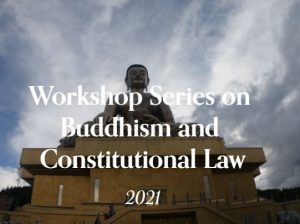
The first challenge I encountered during the first year of my monastic training as a postulant was overcoming the discomfort from the clothes we wore. We had a special uniform—a long-sleeved, loose grey midi robe with long pants. In the winter, we could put on more layers inside and a black coat while outside. But in the hot summer, even when it was over 35ºC (about 95ºF, but it felt like 100ºF due to the humidity), we still needed to wear our uniform day and night without air conditioning. This was really too much for me, especially after I had become so used to the comfortable weather in the Westwood/Santa Monica area of California. We were sweating all the time—it felt like our bodies were soaking in salty water. It was even worse during morning/evening services and chanting ceremonies because we were required to wear another black maxi robe with long sleeves. I could not imagine how I would tolerate the habit after ordination, which has the additional layer of a long-sleeved maxi robe and long grey tube socks. Because of this, I also felt sympathy for Roman Catholic nuns!

One day during class, some of us proposed a plan to reform the sangha uniform. We did not ask much, just to change the length and size of the sleeves. In the Buddha’s age, monastics exposed their right shoulder. The Tibetan monastic habit also exposes the arms. Even the robes of the Theravada tradition look cool. We argued back and forth with our supervisor, almost like warriors fighting for the benefit of the whole sangha. In the end, our supervisor suggested that we chant “Nam Mo Chin Liang Di Pu Sa Mo He Sa” (南無清涼地菩薩摩訶薩). I felt so frustrated—was this a kind of brainwashing? Why do we need to chant “Cool Ground Bodhisattva” for help when some simple practical changes would resolve the problem? The next day, it was our executive head nun’s class. She seemed to have been notified of our proposal, and she shared how she overcame the heat by contemplating body sensation, just like how we deal with leg pain during long meditation sessions during retreat. She further explained that the purpose of chanting the “Chin Liang Di (Cool Ground) Bodhisattva” was to remind us to cool down our vexed, excited minds.

Days later, it was our Shifu’s class. Obviously, everything was reported to him. He looked at us just like a father looks at his naughty children. He first told us how precious it is to follow the Chinese Buddhist tradition, especially for female monastics. Then he reminded us that Chinese monastics have worn this same habit for hundreds of years. Even now, all members of the sangha members wear it just fine, he noted, adding that we would soon get used to it. “No one will change our habit, not in my lifetime,” he cautioned. “Besides, as Chan practitioners, instead of trying to change conditions for the comfort of our six sense organs, we need to constantly train our minds to bear and accept discomfort to a larger extent; this is the practice of forbearance . . .” None of us ever talked about the uniform reform plan again.
That was the first time I realized how avidly I used to avoid discomfort. As a monastic, I cannot wear fewer clothes or turn on the air conditioning when I feel hot. I need to train my mind to remain at ease when my six sense organs are out of their comfort zone. Later on, after full ordination, I began to understand why we have 350 precepts to keep. Some of them help us to avoid the distraction of the attachments of our six sense organs in daily life. For example, we wear only grey, black, and dark brown, so there are no beautiful colors from which to pick and choose. Our heads are shaved, so there’s no need to worry about hairstyles or our appearance. Everything we use, including soaps and lotions, is odor-free to avoid attachment to fragrance, etc.

Among the six sense organs, mind training is definitely the hardest. Body sensation is also very hard to handle, such as heat, cold, itching, and pain, especially from sickness. It was a live example for us to see how Shifu handled his pain from cancer and the itching from kidney dialysis during his final four years. He told us that his body was in great pain and that the itching went deep into his bones, yet his mind was not suffering or vexed. Despite such extreme conditions, he still managed to do what needed to be done until the day his body was no longer functional. I don’t know if my practice will ever reach the level at which my mind can totally detach from the influence of extreme body discomfort, but I know for sure that it can be achieved.
References
Master Sheng Yen. 2010. 美好的晚年 (My Wonderful Late Life). Taipei: Fagu wenhua.
See more
Related features from Buddhistdoor Global
The Daily Practice of a Modern Chinese Buddhist Nun: Learning Chan and Leaving Home
The Daily Practice of a Modern Chinese Buddhist Nun: Becoming a Nun and the Practice of Amitabha Recitation
The Daily Practice of a Modern Chinese Buddhist Nun: Meeting Master Sheng-Yen and Taking the Bodhisattva Vows











